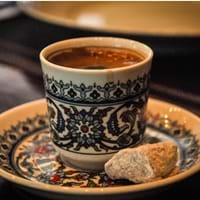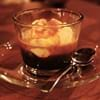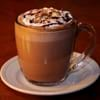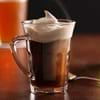Espresso vs Turkish Coffee
What is
Color
Black, Dark Brown
Dark Brown
Types
Espresso Romano, Espresso Machiatto, Espresso con Panna, Café Latte, Flat White, Café Breve, Cafe Mocha, Americano
No types
Milk Content
Little
Full cup
Taste
Bitter
Sweet
Serving Style
Hot
Hot
Additives
Hot water, Milk
Cardamom, Sugar
Number of Servings
1
1
Time Required
Preparation Time
5 minutes
5
5 minutes
5
Cooking Time
5 minutes
5
10 minutes
6
Benefits
Health Benefits
Physical Benefits
Not Available
Alzheimer's disease, Helps heart protection, Improves digestion
Mental Health Benefits
Enhance memory
Mental alertness
Disease Prevention
Cures Alzheimer's disease, Prevents Parkinson's disease, Reduces cardiovascular diseases
Not Available
Overall Health Benefits
Useful for weight control
Not Available
Hair Care
Not Available
Not Available
Skin Care
Not Available
Not Available
Side Effects
Low Risk Side Effects
Acidity, Sleep disorders
Anxiety, Insomnia, Tremor
High Risk Side Effects
Increases level of cholesterol, Slows the blood flow in heart, Thinning bones (osteoporosis)
Back pain, Irregular heartbeat, Migraine headaches, Problems in bladder
Caffeine
Caffeine Content
75.00 mg
17
100.00 mg
24
Serving Size in USA
Short (8 floz)
Not Available
100.00 mg
22
Tall (12 floz)
75.00 mg
7
Not Available
Grande (16 floz)
150.00 mg
7
Not Available
Serving Size in UK
Short (236 ml)
Not Available
100.00 mg
22
Tall (354 ml)
75.00 mg
5
Not Available
Grande (473 ml)
150.00 mg
5
Not Available
Caffeine Level
Moderate
Moderate
Safe Level
400.00 mg
300.00 mg
Harmful Level
500.00 mg
500.00 mg
Effects of Caffeine
Headache, Increased thirst, Irritability, Jitteriness, Vomiting
Blood pressure, Cholesterol rise, Hypertension
Calories
Without Sugar
9.00 Kcal
4
29.00 Kcal
9
With Sugar
29.00 Kcal
22
46.00 Kcal
28
With Skimmed Milk
13.00 Kcal
4
112.00 Kcal
14
With Skimmed Milk and Sugar
43.00 Kcal
4
129.00 Kcal
14
With Whole Milk
19.00 Kcal
3
175.00 Kcal
15
With Whole Milk and Sugar
50.00 Kcal
3
192.00 Kcal
12
Calories With Additives
50.00 Kcal
10
190.00 Kcal
22
Fats
0.20 gm
5
0.02 gm
2
Carbohydrates
1.70 gm
14
11.57 gm
30
Protein
0.10 gm
37
0.13 gm
36
Brands
Brands
Aloha, Cafejo, Espressione, Illy, Lavazza, Marley
Elite, Mehmet Efendi Turkish Coffee, Selamlique, Turk kahvesi
History
Originated in
Italy
Turkey
Origin Period
16th Century
Approx 15th Century
Popularity
Famous
Famous
Difference Between Espresso and Turkish Coffee
Both Espresso and Turkish Coffee have different features, but its interesting to compare and see the difference between Espresso and Turkish Coffee. Here, you will get to know the difference between Espresso and Turkish Coffee in accordance with their caffeine content, probable side effects and many more interesting facts like Espresso Benefits and Turkish Coffee Benefits in the upcoming sections.











